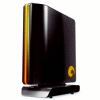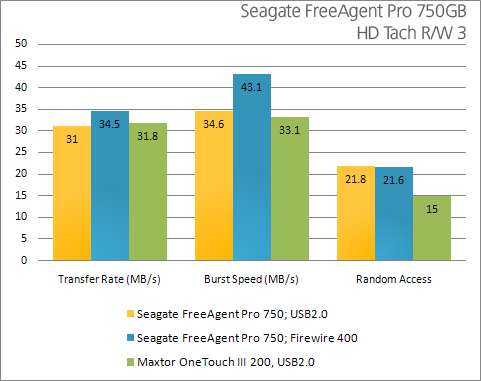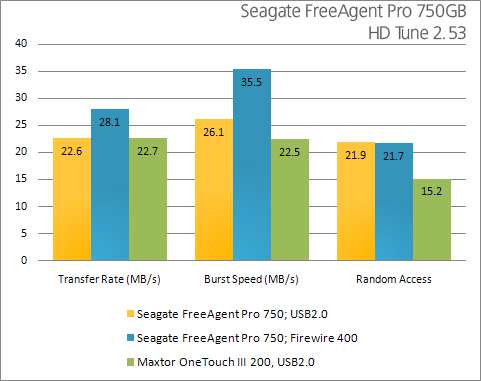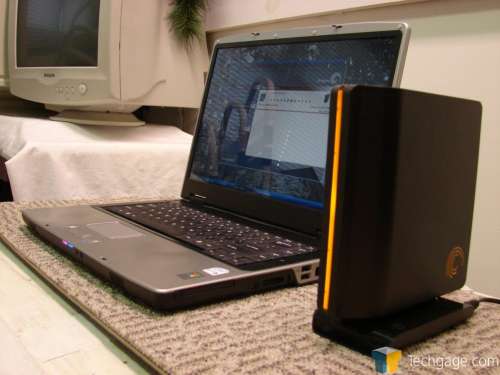- Qualcomm Launches Snapdragon 4 Gen 2 Mobile Platform
- AMD Launches Ryzen PRO 7000 Series Mobile & Desktop Platform
- Intel Launches Sleek Single-Slot Arc Pro A60 Workstation Graphics Card
- NVIDIA Announces Latest Ada Lovelace Additions: GeForce RTX 4060 Ti & RTX 4060
- Maxon Redshift With AMD Radeon GPU Rendering Support Now Available
Seagate FreeAgent Pro 750GB

The Seagate FreeAgent Pro combines a sleek external design with a solid, reliable drive inside. But the FreeAgent’s feature set doesn’t end there. Here’s a look at what makes the Seagate FreeAgent Pro such an attractive solution for anyone looking to add external storage to their system.
Page 5 – Performance Testing
To test this drive’s performance, I’ll be comparing it to another external hard drive I have access to (read: borrowed), a Maxtor OneTouch III 200GB without the FireWire 400 ports. For the test machine, I’ll be using my trusty Gateway NX560XL laptop computer, running Windows XP Media Center Edition 2005. I’ll also test the FireWire 400 input module, to see what performance boost that connection option offers.
Unfortunately, I don’t have any eSATA-capable machines, and I don’t know anyone who does, so I won’t be able to test the eSATA function, but it should offer a considerable advantage over both the FireWire 400 and the USB 2.0 connectivity options. At present, only a handful of the newest PCs and the newest enthusiast motherboards offer eSATA connectivity, but it’s a safe bet that the quantity of available machines and motherboards will broaden as time passes.
- Test System
- Intel Centrino Duo T2300 (1.66GHz, Yonah)
- 1GB DDR2 667 memory (dual-channel mode)
- Gateway M465 Motherboard (i945PM)
- Mobility Radeon X1400 Graphics
- Fujitsu 80GB 7200RPM SATA hard drive
- SigmaTel Onboard Audio (sux)
For all tests, all unnecessary programs running in the background were closed, and McAfee VirusScan’s On-Access Scan was disabled. To test the Seagate FreeAgent Pro 750GB and the Maxtor OneTouch III 200GB, I used both HD Tach RW3 and HD Tune 2.53.
The test employed here is the Long Bench (32MB zones).

From this test, two things can be seen. First of all, there isn’t much difference between the Maxtor OneTouch III and the Seagate FreeAgent Pro, except when it comes to random access times. However, the discrepancy is due to the different sizes of the drives. Larger capacity drives typically exhibit higher random access times than smaller drives, and this is so for internal drives as well as external ones. When connecting with FireWire 400, there’s a gain of about 20% in burst speed over USB2.0.
This test was run with its default settings.

This benchmark turned in lower numbers overall, but reflects similar trends in performance. When running with the FireWire 400 connection module, there’s a 27% gain in performance. As before, the Maxtor pulls out a faster random access time, but this doesn’t help its transfer rate.
So, what conclusions can be drawn from these two tests? Both the Seagate FreeAgent Pro and the Maxtor OneTouch III are plenty fast enough for recording and playback of HD-quality video, so they both have a potential application for media center PCs. The performance of both drives is about comparable to a 7200rpm laptop drive, but an internal 7200RPM, SATA2 drive like the previously-reviewed Seagate Barracuda 7200.10 320GB handily outclasses both external solutions.
For gaming, I’d recommend sticking with internal storage, though the FreeAgent can still serve as a repository for patches and disc images, which can come in handy at LAN parties if you’d rather not tote an enormous CD or DVD binder. Overall, the performance of the FreeAgent Pro is on par with other external hard drives, but there’s nothing really surprising here. Had I been able to test the FreeAgent Pro using eSATA, the results might have been much different, but given the limited market penetration of eSATA at this point, such performance numbers would be irrelevant to the vast majority of users.
As with all my other reviews, I like to assess the noise produced by the products I’m evaluating. The FreeAgent Pro is only very barely audible in a quiet room, but it’s no noisier than the typical internal hard drive. The little noise this drive produces is extremely soft, and free of any high-pitched whirring. Seek noise was virtually inaudible as well. If you put your ear up to the casing, you can hear the ocean.
|
|
Support our efforts! With ad revenue at an all-time low for written websites, we're relying more than ever on reader support to help us continue putting so much effort into this type of content. You can support us by becoming a Patron, or by using our Amazon shopping affiliate links listed through our articles. Thanks for your support!





